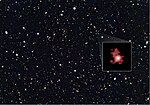astro.wikisort.org - Meteorite
Kepler-1638 is a G4V-type star located 4,973 light years away in the constellation of Cygnus.[1] At least one exoplanet has been found orbiting the star: Kepler-1638b.[4][5][6][7][8] This planet is a potentially habitable Super-Earth. As of January 2021, Kepler-1638 is the farthest star with a known potentially habitable exoplanet.[9]
 Constellation where Kepler-1638 is located | |
| Observation data Epoch J2000.0 Equinox J2000.0 (ICRS) | |
|---|---|
| Constellation | Cygnus[1] |
| Right ascension | 19h 41m 55.76719s[2] |
| Declination | +48° 31′ 27.9995″[2] |
| Apparent magnitude (V) | 14.769±0.206[3] |
| Characteristics | |
| Evolutionary stage | main sequence star |
| Spectral type | G4V[citation needed] |
| Apparent magnitude (J) | 13.550±0.023[2] |
| Apparent magnitude (H) | 13.204±0.024[2] |
| Apparent magnitude (K) | 13.138±0.035[2] |
| Variable type | Planetary transit,[3] rotationally variable[2] |
| Astrometry | |
| Proper motion (μ) | RA: -5.138[2] mas/yr Dec.: 5.859[2] mas/yr |
| Parallax (π) | 0.6269 ± 0.0210 mas[2] |
| Distance | 5,200 ± 200 ly (1,600 ± 50 pc) |
| Details[3] | |
| Mass | 0.9700+0.0490 −0.0590 M☉ |
| Radius | 0.9500+0.1660 −0.0790 R☉ |
| Temperature | 5710.0+96.696 −111.431 K |
| Metallicity [Fe/H] | −0.0100+0.1410 −0.1880 dex |
| Age | 4.37+4.19 −2.59 Gyr |
| Other designations | |
| Database references | |
| SIMBAD | data |
Planetary system
| Companion (in order from star) |
Mass | Semimajor axis (AU) |
Orbital period (days) |
Eccentricity | Inclination | Radius |
|---|---|---|---|---|---|---|
| b | 4.16 M🜨 | 0.745+0.021 −0.020 |
259.33683±0.01303 | — | 89.9954+0.0021 −0.0844° |
1.87+0.33 −0.22 R🜨 |
| Discovery | |
|---|---|
| Discovered by | Ames Research Center |
| Discovery date | 2016 |
Detection method | Transit |
| Orbital characteristics | |
Orbital period (sidereal) | 259.337±0.013 d |
| Star | Kepler-1638 |
| Physical characteristics | |
Mean radius | 1.87+0.33 −0.22 REarth |
| Mass | 4.16 MEarth |
Kepler-1638 b is an exoplanet in orbit of its star, Kepler-1638, located in the constellation Cygnus. The planet is a super-Earth, with a radius of 1.87+0.33
−0.22 REarth, and a mass of 4.16 Earths. It has an orbit of 259.337±0.013 days in its system's habitable zone and orbits 0.745 AU from its star. It is the farthest potentially habitable exoplanet discovered, at approximately 2,867 light-years (879 pc) from Earth.[10][8][5][6][7]
References
- Staff (2 August 2008). "Finding the constellation which contains given sky coordinates". DJM.cc. Retrieved 16 July 2020.
- "Kepler-1638". SIMBAD. Centre de données astronomiques de Strasbourg. Retrieved 2 February 2021.
- "Kepler-1638". NASA Exoplanet Archive. Retrieved 2 February 2021.
- "Kepler-1638 (Planet Orbiting Star) Facts". Universe Guide. Retrieved 21 January 2021.
- Burgess, Matt (11 May 2016). "Nasa's Kepler telescope just found 1,284 exoplanets". Wired UK. ISSN 1357-0978. Retrieved 22 January 2021.
- "Exoplanet-catalog". Exoplanet Exploration: Planets Beyond our Solar System. Retrieved 22 January 2021.
- May 2016, Mike Wall 11. "1st Alien Earth Still Elusive Despite Huge Exoplanet Haul". Space.com. Retrieved 22 January 2021.
- Morton, Timothy D.; Bryson, Stephen T.; Coughlin, Jeffrey L.; Rowe, Jason F.; Ravichandran, Ganesh; et al. (May 2016). "False Positive Probabilities for all Kepler Objects of Interest: 1284 Newly Validated Planets and 428 Likely False Positives". The Astrophysical Journal. 822 (2). arXiv:1605.02825. Bibcode:2016ApJ...822...86M. doi:10.3847/0004-637X/822/2/86.
- "The Habitable Exoplanets Catalog - Planetary Habitability Laboratory @ UPR Arecibo". phl.upr.edu. Retrieved 21 January 2021.
- "Kepler-1638 b". NASA Exoplanet Science Institute. 10 May 2016. Retrieved 11 May 2016.
See also
- Habitability of red dwarf systems
- List of potentially habitable exoplanets
Другой контент может иметь иную лицензию. Перед использованием материалов сайта WikiSort.org внимательно изучите правила лицензирования конкретных элементов наполнения сайта.
WikiSort.org - проект по пересортировке и дополнению контента Википедии



